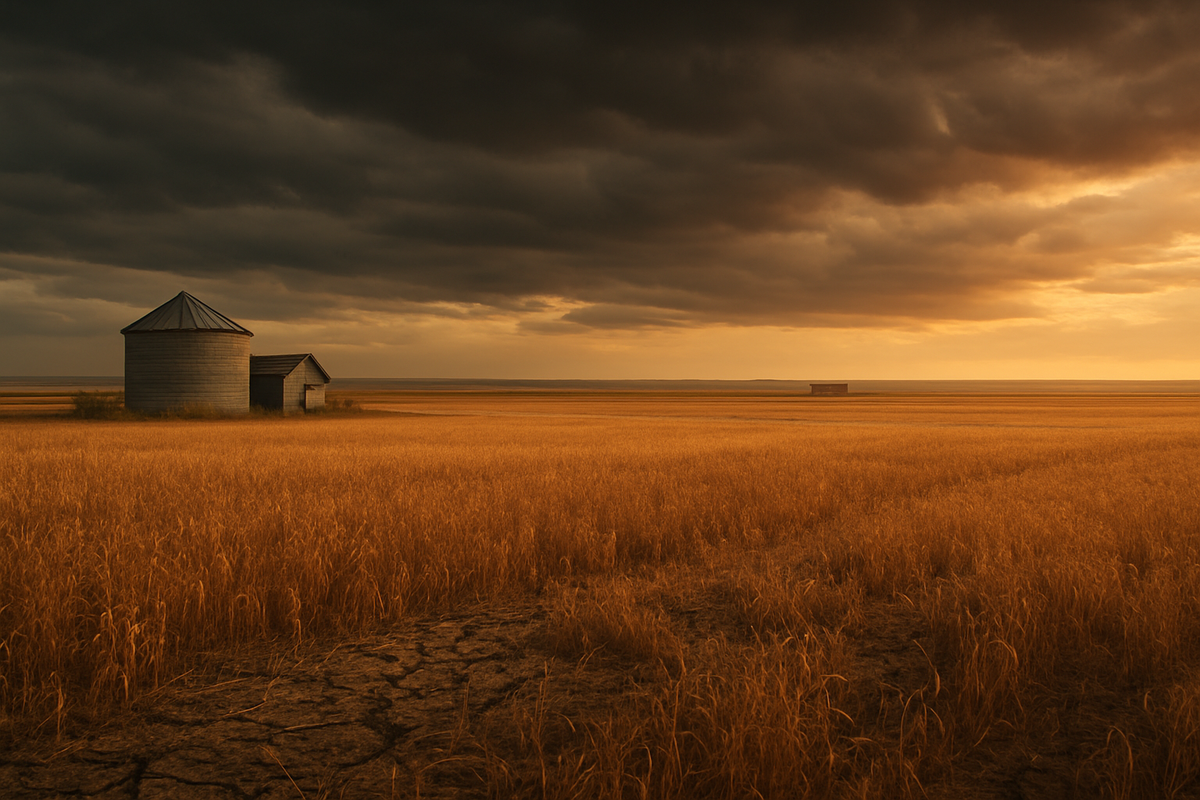
BISMARCK, ND – November 20, 2025 – The heartland of America, specifically North Dakota's rural economy, finds itself at a critical juncture, grappling with a complex array of challenges that are reshaping its agricultural landscape. While farmland prices have shown a surprising resilience, even increasing in value, the state's vital agricultural export sector is experiencing significant headwinds due to ongoing trade disputes and retaliatory tariffs. This precarious situation is further complicated by volatile commodity prices, which offer mixed signals with declining crop receipts offset by strong livestock performance, all while farmers contend with stubbornly high input costs. The reliance on substantial, albeit temporary, government aid in 2025 underscores the fragility of the current economic environment, prompting concerns about the sustainability of rural livelihoods as these payments are set to recede.
This intricate web of economic pressures paints a challenging picture for North Dakota's farmers, agricultural businesses, and the broader rural communities that depend on a robust agricultural sector. The coming months will test the adaptability and resilience of the state's economy as it seeks to navigate trade uncertainties, manage production costs, and prepare for a projected downturn in net farm income in the absence of continued ad-hoc government support.
Unpacking the Economic Crosscurrents: Farmland's Resilience, Export's Decline, and Commodity's Mixed Bag
North Dakota's rural economy in late 2025 presents a series of paradoxes. Perhaps the most striking is the unexpected strength in farmland values. Despite lower net farm incomes in recent years and rising interest rates, cropland values in the state saw a significant 10.55% increase in 2025, marking the fourth consecutive year of double-digit growth. This contributes to an almost 40% surge between 2022 and 2025, pushing the weighted average to $3,534 per acre. Pastureland values followed suit, climbing 8.9% from 2024 to 2025, averaging $1,473 per acre. This growth, particularly pronounced in regions like the North Red River Valley with a 22.1% increase in cropland values, is considered "surprising" given the broader economic environment. However, this momentum is not uniform, with some southern counties experiencing a softening market, and the broader sentiment, as indicated by the Rural Mainstreet Index for October 2025, suggests a lack of robust growth in recent months, with farmland prices staying below neutral growth for 17 of the last 18 months. Cash rental rates, while increasing, have lagged significantly behind land values, up only 4.25% statewide in 2025.
The state's agricultural export sector, a crucial engine for its economy, faces substantial and persistent challenges, primarily stemming from ongoing trade disputes and the resulting tariffs. North Dakota's soybean production, with approximately 90% typically exported and two-thirds historically destined for China, has been particularly hard hit. As of November 2025, China has made no purchases of the 2026 soybean crop, a stark indicator of lost market access as China increasingly turns to South American suppliers. The threat of even higher tariffs on Chinese products, potentially exceeding 100%, casts a long shadow over future trade relations. Overall, retaliatory tariffs from key trading partners like Canada, Mexico, and China could lead to an estimated $414 million loss for North Dakota's soybean exports in 2025 alone. Wheat exports are also highly vulnerable to these trade actions, with significant declines projected. Beyond direct export losses, farmers are facing increased costs for essential inputs, including equipment (due to tariffs on steel, aluminum, and copper) and fertilizers, much of which originates from Canada, further squeezing already tight margins.
The impact of commodity prices on North Dakota's rural economy in 2025 presents a mixed and challenging picture. Crop price projections for the year are generally lower than in the previous year, contributing to tight operating margins. Total crop receipts are expected to decline by 10% in 2025, reaching their lowest level since 2022. This downturn is driven by modest decreases across most crop types, including a projected 12% drop in wheat receipts, an 8% decline in soybean receipts, and a significant 30% reduction in canola cash receipts. In contrast, the livestock sector offers a brighter spot. Cattle prices have been on a cyclical upswing since 2020, reaching record highs through 2025, which is expected to boost cattle cash receipts by 6% in 2025. However, a multi-decade low in cattle inventories has limited the upward pressure on pasture rental rates and the overall potential for growth in this segment. Adding to the pressure, farmers continue to face elevated production expenses for inputs like seed, fuel, oil, and labor, even as some costs like fertilizer and pesticides are projected to decline slightly.
Public Companies Navigating the Agricultural Headwinds
The complex economic environment in North Dakota presents both challenges and potential opportunities for public companies operating within or closely tied to the agricultural sector. Companies involved in agricultural equipment manufacturing, crop input supply, grain handling, and food processing will feel the direct and indirect impacts of slipping farm incomes, volatile commodity prices, and trade disruptions.
Agricultural equipment manufacturers like Deere & Company (NYSE: DE) could face reduced demand for new machinery if North Dakota farmers, facing tighter margins and uncertain futures, postpone capital expenditures. While Deere's global footprint provides diversification, a sustained downturn in key agricultural regions like North Dakota could impact sales of tractors, combines, and other farm implements. Similarly, companies supplying crop inputs such as seeds, fertilizers, and pesticides, including Corteva Agriscience (NYSE: CTVA) and Nutrien Ltd. (TSX: NTR, NYSE: NTR), might see fluctuating demand. While fertilizer prices are projected to decline slightly, overall input costs remain high, and farmers' purchasing decisions will be heavily influenced by their profitability and outlook.
Grain handling and processing companies, such as Archer-Daniels-Midland Company (NYSE: ADM) and Bunge Global SA (NYSE: BG), which operate extensive networks of elevators and processing facilities, are directly impacted by declining export volumes, particularly for soybeans and wheat. Reduced throughput at North Dakota facilities due to trade disputes with China and other nations can lead to lower revenues from storage, merchandising, and transportation services. These companies might also face increased storage costs as farmers struggle to find buyers for their crops. On the other hand, companies with a strong presence in the livestock sector, or those that can pivot to alternative crops or markets, might find some resilience. For instance, firms involved in beef processing or those with diversified portfolios beyond just major commodity crops could be better positioned to weather the storm, though the low cattle inventories in North Dakota limit the immediate upside.
Wider Significance: A Bellwether for Rural America and Global Trade
The challenges unfolding in North Dakota's rural economy are not isolated; they serve as a critical bellwether for broader trends impacting rural America and the global agricultural trade landscape. The phenomenon of resilient farmland prices amidst declining farm incomes highlights a disconnect that could indicate speculative investment, limited alternative investment options, or a long-term belief in agriculture's intrinsic value, rather than immediate profitability. This trend, if sustained, could further exacerbate the entry barriers for new farmers and consolidate land ownership. The reliance on substantial government payments, as seen with the American Relief Act of 2025, mirrors a growing dependency across the U.S. agricultural sector on policy-driven support rather than market fundamentals. This raises questions about long-term fiscal sustainability and the true economic health of farming communities when such aid recedes.
The ongoing trade disputes, particularly with China and Canada, represent a significant shift in global agricultural trade patterns. North Dakota's soybean woes are a microcosm of how protectionist policies and retaliatory tariffs can fundamentally alter supply chains, forcing traditional buyers to seek alternative sources (e.g., South America for China's soybeans). This fragmentation of global markets creates long-term uncertainty for export-dependent agricultural regions and can lead to permanent market share losses. The ripple effects extend beyond farmers to local businesses, agricultural lenders, and equipment suppliers, who all face increased risk and reduced economic activity. Regulatory and policy implications are profound, with the current administration's trade stance directly impacting farm profitability. Furthermore, the looming expiration of enhanced Affordable Care Act tax credits, poised to significantly increase health insurance costs for farm families, adds another layer of financial pressure, demonstrating how broader social policies intersect with agricultural economics. Historically, such periods of low commodity prices, high input costs, and trade tensions evoke comparisons to the farm crises of the 1980s, underscoring the potential for widespread economic distress if not adequately addressed.
What Comes Next: Adaptations, Diversification, and Policy Pivots
Looking ahead, North Dakota's rural economy faces a critical period of adaptation and potential transformation. In the short term, the most pressing concern for farmers will be managing the projected 48% decline in net farm income in 2026, as the substantial ad-hoc government payments from the American Relief Act of 2025 are expected to return to historical levels. This necessitates stringent cost management, optimizing planting decisions, and potentially seeking alternative revenue streams. Navigating persistent trade tensions will require farmers and agricultural businesses to explore new export markets beyond traditional partners or to focus more on domestic consumption. Strategic pivots might include diversifying crop rotations to less export-reliant commodities or investing in value-added processing within the state to capture more of the food supply chain's value.
In the long term, the challenges could spur innovation and technological adoption aimed at increasing efficiency and reducing reliance on external inputs. There may be a renewed focus on sustainable farming practices that can lower costs and potentially open doors to new, environmentally conscious markets. Market opportunities, though currently constrained by low inventories, could emerge in the livestock sector if herd sizes recover, offering a more stable revenue stream less susceptible to international trade disputes. Furthermore, the political landscape will play a crucial role. Future farm bills, trade agreements, and domestic support programs will dictate the economic environment for North Dakota's agriculture. Potential scenarios range from a continued struggle with depressed crop prices and limited export access, leading to further consolidation and rural out-migration, to a more optimistic outlook where new trade deals are forged, commodity prices rebound, and strategic investments in agricultural technology and diversification create a more resilient and profitable sector.
Comprehensive Wrap-Up: A Test of Resilience and Strategic Foresight
North Dakota's rural economy is currently grappling with a complex and often contradictory set of circumstances. The surprising resilience of farmland prices offers a glimmer of underlying value, yet it stands in stark contrast to the severe headwinds faced by the state's agricultural export sector and the mixed signals from commodity markets. The significant reliance on government payments in 2025 has provided a crucial, though temporary, buffer, masking deeper structural challenges related to trade policy and high production costs. As these payments are set to recede, the true test of the state's agricultural resilience will emerge in 2026 and beyond.
Moving forward, the market will be keenly watching several key indicators. Investors should monitor developments in international trade negotiations, particularly concerning U.S. relations with China and Canada, as any resolution or escalation will directly impact export-dependent commodities like soybeans and wheat. Fluctuations in global commodity prices, especially for major crops and livestock, will dictate farmer profitability. Furthermore, the evolution of agricultural policy, including the next farm bill and any further ad-hoc relief measures, will be critical. The capacity of North Dakota's farmers and agricultural businesses to adapt through diversification, cost management, and the exploration of new markets will be paramount. Ultimately, the current environment is a profound reminder of the interconnectedness of global trade, domestic policy, and the fundamental economics of farming, demanding strategic foresight and adaptability from all stakeholders to secure a sustainable future for the state's vital rural economy.
This content is intended for informational purposes only and is not financial advice





